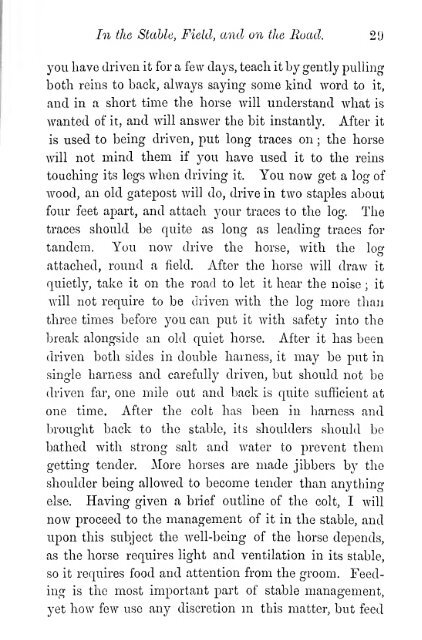The management and treatment of the horse in the stable, field, and ...
The management and treatment of the horse in the stable, field, and ...
The management and treatment of the horse in the stable, field, and ...
You also want an ePaper? Increase the reach of your titles
YUMPU automatically turns print PDFs into web optimized ePapers that Google loves.
In <strong>the</strong> Stable, Field, <strong>and</strong> on <strong>the</strong> Road. 29<br />
you have driven it for a few days, teach it by gently pull<strong>in</strong>g<br />
both re<strong>in</strong>s to back, always say<strong>in</strong>g some k<strong>in</strong>d word to it,<br />
<strong>and</strong> <strong>in</strong> a short time <strong>the</strong> <strong>horse</strong> will underst<strong>and</strong> what is<br />
wanted <strong>of</strong> it, <strong>and</strong> will answer <strong>the</strong> bit <strong>in</strong>stantly. After it<br />
is used to be<strong>in</strong>g driven, put long traces on ; <strong>the</strong> <strong>horse</strong><br />
will not m<strong>in</strong>d <strong>the</strong>m if you have used it to <strong>the</strong> re<strong>in</strong>s<br />
touch<strong>in</strong>g its legs when driv<strong>in</strong>g it. You now get a log <strong>of</strong><br />
wood, an old gatepost will do, drive <strong>in</strong> two staples about<br />
four feet apart, <strong>and</strong> attach your traces to <strong>the</strong> log. <strong>The</strong><br />
traces should be quite as long as lead<strong>in</strong>g traces for<br />
t<strong>and</strong>em. You now drive <strong>the</strong> <strong>horse</strong>, with <strong>the</strong> losr<br />
attached, round a <strong>field</strong>. After <strong>the</strong> <strong>horse</strong> will draw it<br />
quietly, take it on <strong>the</strong> road to let it hear <strong>the</strong> noise ; it<br />
will not require to be driven with <strong>the</strong> log more than<br />
three times before you can put it with safety <strong>in</strong>to <strong>the</strong><br />
break alongside an old quiet <strong>horse</strong>. After it has been<br />
driven both sides <strong>in</strong> double harness, it may be put <strong>in</strong><br />
s<strong>in</strong>gle harness <strong>and</strong> carefully driven, but should not be<br />
driven far, one mile out <strong>and</strong> back is quite sufficient at<br />
one time. After <strong>the</strong> colt has been <strong>in</strong> harness <strong>and</strong><br />
brought back to <strong>the</strong> <strong>stable</strong>, its shoulders should be<br />
ba<strong>the</strong>d with strong salt <strong>and</strong> water to prevent <strong>the</strong>m<br />
gett<strong>in</strong>g tender. More <strong>horse</strong>s are made jibbers by <strong>the</strong><br />
shoulder be<strong>in</strong>g allowed to become tender than anyth<strong>in</strong>g<br />
else. Hav<strong>in</strong>g given a brief outl<strong>in</strong>e <strong>of</strong> <strong>the</strong> colt, I will<br />
now proceed to <strong>the</strong> <strong>management</strong> <strong>of</strong> it <strong>in</strong> <strong>the</strong> <strong>stable</strong>, <strong>and</strong><br />
upon this subject <strong>the</strong> well-be<strong>in</strong>g <strong>of</strong> <strong>the</strong> <strong>horse</strong> depends,<br />
as <strong>the</strong> <strong>horse</strong> requires light <strong>and</strong> ventilation <strong>in</strong> its <strong>stable</strong>,<br />
so it requires food <strong>and</strong> attention from <strong>the</strong> groom. Feed<strong>in</strong>g<br />
is <strong>the</strong> most important part <strong>of</strong> <strong>stable</strong> <strong>management</strong>,<br />
yet how few use any discretion <strong>in</strong> this matter, but feed
















